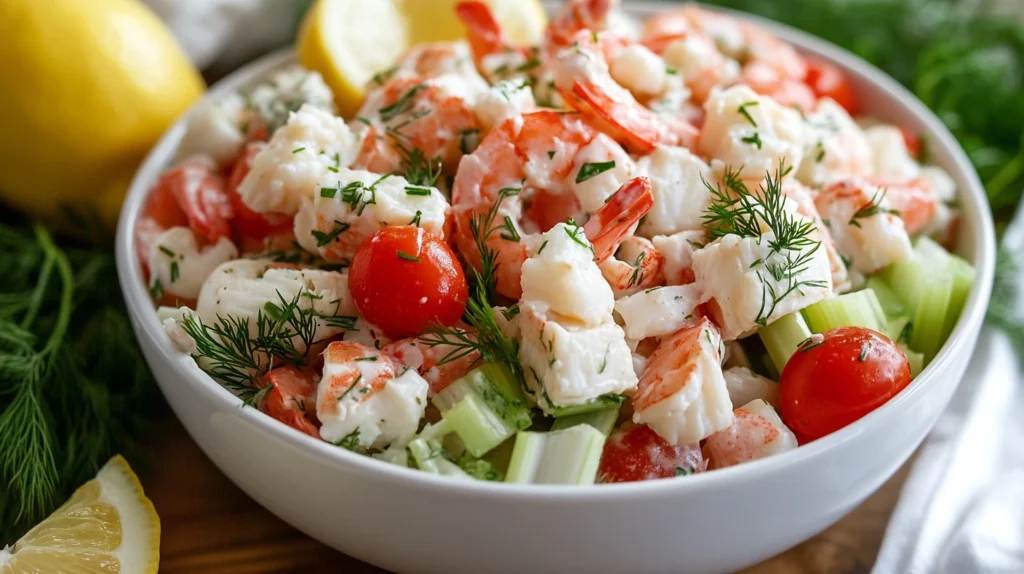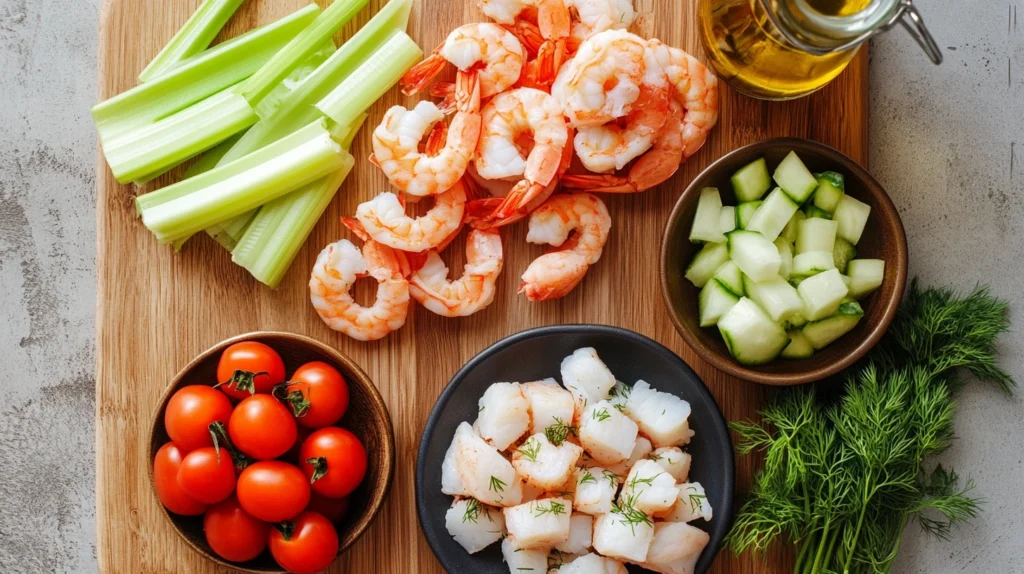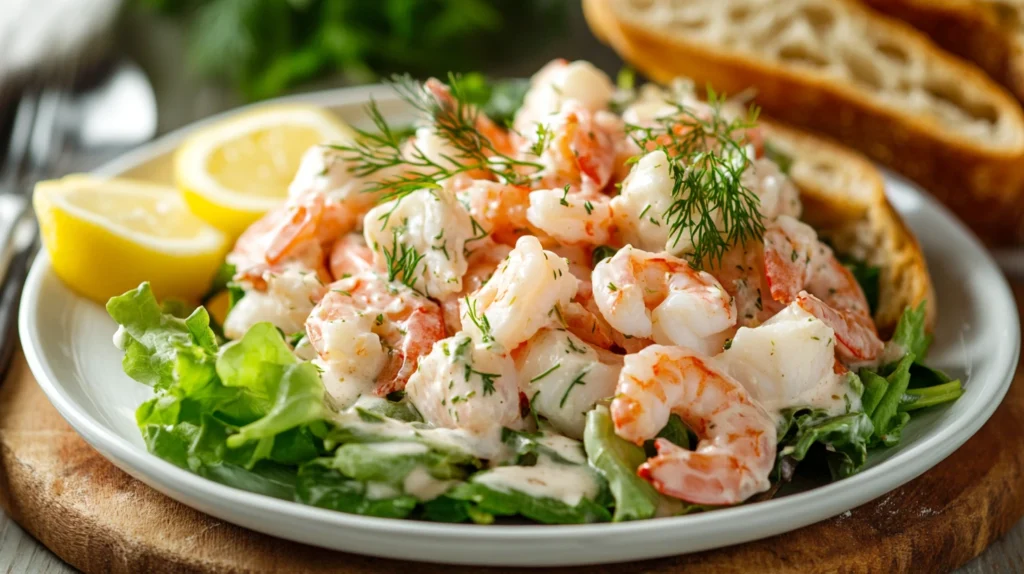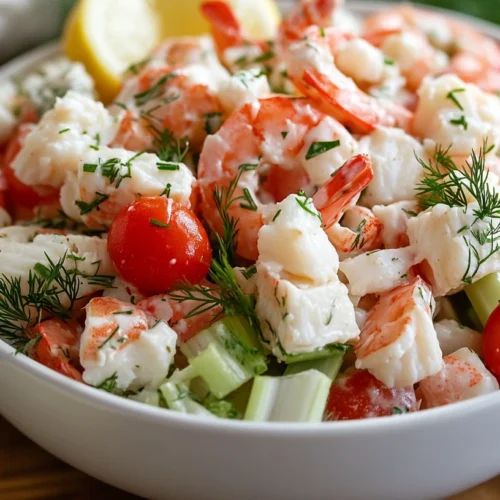Seafood salad is a tasty dish that blends fresh seafood with crisp vegetables and tangy dressings. It’s a flexible recipe, perfect for quick family meals, fancy dinners, or a healthy lunch. Packed with protein, omega-3s, and important nutrients, seafood salad is both delicious and nutritious.
In this article, you’ll discover how to make a seafood salad that’s simple to prepare and looks great on the table. Whether you’re an experienced cook or just starting out, this recipe will help you create a meal that’s sure to impress your guests while staying light and healthy.

Ingredients for the Best Seafood Salad Recipe
Making a seafood salad full of flavor and nutrients starts with picking the right ingredients. Here are the basics for this tasty recipe.

Primary Seafood for a Healthy Seafood Salad
The star of the seafood salad is, of course, the seafood! Here’s what you’ll need:
- Shrimp – Use fresh or frozen medium-sized shrimp. Clean them by peeling and removing the vein, then cook until they turn pink for a sweet flavor.
- Crab Meat – Fresh crab adds great taste, but if you don’t have it, good-quality canned or imitation crab works too.
- Scallops – These soft and tasty bites have a mild, sweet flavor. Cook them quickly in a pan to enhance their taste.
- Optional Additions – You can also add squid, mussels, or lobster chunks for a fancier dish.
Vegetables That Enhance Your Seafood Salad Recipe
Adding a variety of vegetables and greens not only makes the salad visually appealing but also boosts its nutritional value. Consider including:
- Mixed Greens – A combination of spinach, arugula, and romaine lettuce creates a fresh, crisp base.
- Cucumbers – Thinly sliced cucumbers add a refreshing crunch.
- Bell Peppers – Red, yellow, and orange bell peppers brighten the salad and provide natural sweetness.
- Cherry Tomatoes – Their juicy sweetness pairs well with the savory seafood.
- Red Onions – Thinly sliced red onions offer a mild tang.
Optional Additions to Elevate Your Seafood Salad
For added texture and flavor, consider including the following ingredients:
- Avocado – Diced avocado brings a creamy richness to the salad.
- Nuts or Seeds – Toasted almonds, sunflower seeds, or walnuts add crunch.
- Fruits – Fresh mango, orange segments, or pomegranate seeds provide a hint of sweetness.
Spices and Dressings for Taste Enhancement
A well-crafted dressing ties the salad together. You’ll need:
- Olive Oil – A good-quality extra virgin olive oil is a must.
- Garlic – Minced garlic provides depth of flavor.
- Herbs – Fresh dill, parsley, and cilantro elevate the seafood’s natural taste.
- Seasonings – Salt, black pepper, paprika, and a dash of cayenne for subtle heat.
By gathering these ingredients, you’re one step closer to crafting a seafood salad that’s as delicious as it is nutritious.
Step-by-Step Guide to Making a Seafood Salad Recipe
Preparing a seafood salad is straightforward and enjoyable. Follow these detailed steps to ensure a dish that’s both visually appealing and full of flavor.
How to Prepare the Seafood for Your Salad
Proper preparation of the seafood is key to a flavorful salad:
- Shrimp – If using raw shrimp, peel, devein, and rinse them under cold water. Boil or steam them until they turn pink and opaque, usually 3–5 minutes. Drain and allow them to cool.
- Crab Meat – If using fresh crab, remove the meat carefully from the shell. For canned or imitation crab, ensure it’s drained and flaked into bite-sized pieces.
- Scallops – Rinse scallops and pat them dry. Heat a skillet with a drizzle of olive oil and sear them on medium heat for 2–3 minutes per side until golden brown. Let cool before adding to the salad.
- Optional Additions – If including calamari or mussels, cook them lightly with olive oil and garlic, then set aside to cool.
Chopping and Preparing Vegetables
To balance the seafood’s rich flavors, prep the vegetables with care:
- Mixed Greens – Rinse thoroughly, then pat dry or spin in a salad spinner to remove excess water. Tear large leaves into smaller, manageable pieces.
- Cucumbers – Slice thinly into rounds or half-moons. For added texture, peel them partially to create a striped pattern.
- Bell Peppers – Remove seeds and slice into thin strips.
- Cherry Tomatoes – Halve or quarter them for easy mixing and eating.
- Red Onions – Slice finely into thin rings or strips for a mild tang without overpowering the salad.
Making the Perfect Dressing for a Seafood Salad Recipe
The dressing ties the entire dish together. Here’s how to make a simple, tangy seafood salad dressing:
- In a small bowl, whisk together:
- 4 tablespoons of extra virgin olive oil
- 2 tablespoons of freshly squeezed lemon juice
- 1 minced garlic clove
- 1 teaspoon of Dijon mustard (optional, for depth)
- A pinch of salt, black pepper, and paprika
- Freshly chopped dill or parsley for aroma and flavor
- Taste and adjust seasonings as needed.
Combining and Presenting the Salad
- Arrange the cooled seafood evenly on top of the greens.
- Add the vegetables, distributing them for an eye-catching presentation.
- Drizzle the dressing evenly over the salad, tossing gently to coat every ingredient.
- For a final touch, garnish with avocado slices, toasted nuts, or fresh herbs.
By following these steps, you’ll create a seafood salad that’s not only delicious but also a visual masterpiece.
Tips for Creating a Nutritious Seafood Salad Recipe
Making the best seafood salad takes more than just following a recipe. These simple tips will help your salad shine in both taste and looks.
Balancing Flavors in a Healthy Seafood Salad
Achieving a harmonious blend of flavors is key to a memorable seafood salad. Keep these tips in mind:
- Balance Sweet and Tangy – Incorporate ingredients like cherry tomatoes or citrus fruits for a natural sweetness, balanced by the tang of the lemon-based dressing.
- Add a Hint of Spice – A sprinkle of cayenne pepper or a dash of hot sauce in the dressing can provide a subtle kick without overpowering the seafood.
- Contrast Textures – Mix soft ingredients like avocado with crunchy additions such as cucumbers or nuts for a satisfying bite.
Choosing the Best Seafood for Your Salad Recipe
Freshness is paramount for seafood salads. Follow these guidelines to select the best seafood:
- Inspect the Seafood – Fresh shrimp, crab, and scallops should have a clean, ocean-like smell. Avoid any seafood with an ammonia-like odor.
- Opt for Local Options – If possible, purchase seafood from a trusted local market for peak freshness.
- Frozen is Fine – If fresh seafood isn’t available, high-quality frozen options can be just as good. Thaw them properly in the refrigerator before use.
Storing and Serving Tips
Seafood salad tastes best when prepared fresh, but proper storage can keep it flavorful for longer:
- Refrigeration – Store the salad in an airtight container and refrigerate for up to 2 days. Keep the dressing separate if you plan to store leftovers.
- Serve Chilled – For the best flavor, serve the salad cold. Place it in the fridge for 30 minutes before serving.
- Avoid Freezing – Freezing seafood salad can compromise its texture, especially with fresh vegetables and greens.

Variations for Dietary Preferences
Make the seafood salad more inclusive with these easy variations:
- Gluten-Free – Ensure all dressings and condiments are free of gluten-containing additives.
- Keto-Friendly – Skip sugary dressings and fruits, and add more healthy fats like avocado and olive oil.
- Low-Sodium – Opt for fresh seafood instead of canned varieties, and season lightly with salt-free herbs and spices.
- Vegetarian Option – Replace seafood with plant-based alternatives like hearts of palm, artichoke hearts, or marinated tofu.
Presentation Matters
A beautifully presented seafood salad is as appealing to the eyes as it is to the palate. Arrange ingredients thoughtfully:
- Layer Ingredients – Place greens first, followed by seafood, then vegetables for a layered look.
- Use a Large Bowl – A wide, shallow bowl allows for even distribution of the ingredients.
- Add Garnishes – Fresh herbs, lemon wedges, or edible flowers can make the salad look restaurant-worthy.
By using these tips, you’ll make your seafood salad taste better and turn it into a highlight for any event.
Health Benefits of a Seafood Salad Recipe
Seafood salad isn’t just delicious; it’s also full of nutrients that make it a great choice for a healthy diet. Let’s explore the top health benefits of this dish.
Nutritional Value of Seafood
Seafood is the star ingredient in this salad, offering a wealth of health benefits:
- Rich in Omega-3 Fatty Acids – Seafood like shrimp, crab, and scallops are excellent sources of omega-3s, which support brain health, reduce inflammation, and promote heart health.
- High-Quality Protein – Seafood provides lean protein that helps with muscle repair, energy, and satiety, making it ideal for active individuals and weight management.
- Essential Vitamins and Minerals – Nutrients like selenium, iodine, and vitamin B12 are abundant in seafood and crucial for energy production and overall wellness.
Benefits of Including Vegetables
The vegetables in a seafood salad contribute both flavor and nutrition:
- Fiber-Rich Ingredients – Vegetables like cucumbers, bell peppers, and cherry tomatoes are loaded with dietary fiber, promoting digestive health and keeping you feeling full.
- Vitamins and Antioxidants – Brightly colored vegetables are rich in vitamins A, C, and E, which boost the immune system and combat oxidative stress.
- Low-Calorie Additions – Vegetables add volume and texture without significantly increasing calorie content, making seafood salad a light yet satisfying meal.
Low-Calorie and Protein-Rich Meal
Seafood salad is a go-to choice for those looking to maintain or lose weight while still enjoying flavorful meals:
- Low in Calories – The combination of lean seafood and fresh vegetables keeps the calorie count low while delivering essential nutrients.
- Keeps You Full – The high protein content in seafood, combined with the fiber from vegetables, promotes satiety, reducing the likelihood of overeating.
- Supports Metabolism – The iodine in seafood supports thyroid function, which is essential for a healthy metabolism.
Supports Heart Health
One of the standout benefits of seafood salad is its contribution to cardiovascular health:
- Omega-3 Fatty Acids – These healthy fats reduce the risk of heart disease by lowering triglycerides and preventing blood clots.
- Low in Saturated Fats – Unlike red meat, seafood is low in unhealthy fats, making it a heart-friendly protein choice.
- Potassium-Rich – Many seafood and vegetable ingredients contain potassium, which helps regulate blood pressure.
Perfect for Special Diets
Seafood salad is versatile and easily adaptable for various dietary needs:
- Paleo and Keto-Friendly – Packed with natural, whole ingredients and low in carbohydrates, seafood salad is perfect for these diets.
- Gluten-Free – Naturally gluten-free, this dish is safe for those with gluten sensitivities or celiac disease when prepared with clean, gluten-free ingredients.
- Mediterranean Diet Approved – With its emphasis on seafood, olive oil, and fresh vegetables, seafood salad aligns perfectly with this heart-healthy eating pattern.
Boosts Energy and Mood
The combination of seafood and fresh ingredients can positively impact energy levels and mental well-being:
- Brain-Boosting Nutrients – Omega-3s and B vitamins in seafood support cognitive function and may reduce symptoms of depression.
- Natural Energy Sources – The healthy fats, protein, and fiber in this dish provide sustained energy throughout the day.
- Mood-Enhancing Benefits – Magnesium and vitamin D found in seafood are linked to improved mood and reduced stress.
By incorporating seafood salad into your meal rotation, you’re not only treating your taste buds but also nurturing your body with essential nutrients.
Pro Tips for a Perfect Salad
- Try pairing this salad with a refreshing Lemon Cookie for a complete meal.
- For a creamy twist, serve with a side of Cherry Cheesecake for dessert.
- For those seeking a heartier dish, pair this salad with Rotisserie Chicken Leftovers for a protein-packed option.
Frequently Asked Questions
How long will seafood salad stay good in the fridge?
Seafood salad stays fresh in the fridge for 1–2 days if kept in a sealed container. To keep it tasty:
- Refrigerate Quickly – Put the salad in the fridge right after making it.
- Check for Freshness – Seafood can go bad fast. Look for bad smells or changes in texture before eating.
- Store Dressing Separately – Keep the dressing in a separate container to stop the vegetables from getting soggy.
What are the ingredients in a seafood extender?
Seafood extender, also known as imitation seafood or surimi, is a processed product made to mimic the texture and taste of crab or other seafood. Its main ingredients are:
- Surimi – A paste made from white fish like pollock or hake.
- Starch – Often wheat, potato, or tapioca starch is used to bind the mixture.
- Egg Whites or Soy Protein – For texture and added protein.
- Flavorings – Crab extract or other seafood flavors are added for taste.
- Coloring – Often orange or red coloring is used on the exterior to imitate real crab.
What is in Big Y seafood salad?
Big Y’s seafood salad typically features a mix of imitation crab (seafood extender), mayonnaise, and seasonings, along with optional ingredients like celery for crunch. Exact recipes may vary slightly, but the main components include:
- Imitation Crab (Surimi)
- Mayonnaise
- Celery or Vegetables
- Seasonings – Likely salt, pepper, and sometimes dill or parsley.
For precise ingredient details, refer to the product label at Big Y or their website.
What is a good side dish for crab salad?
Crab salad pairs wonderfully with a variety of side dishes that complement its light, refreshing flavor. Consider the following options:
- Crackers or Bread – Serve with buttered crostini, crackers, or a crusty baguette for scooping.
- Green Salad – A simple arugula or mixed greens salad with a lemon vinaigrette adds freshness.
- Grilled Vegetables – Asparagus, zucchini, or bell peppers offer a smoky contrast.
- Rice Pilaf – Lightly seasoned rice pilaf provides a filling, neutral side.
- Corn on the Cob – A buttery ear of corn enhances the sweetness of crab salad.
- Potato Salad – A creamy or tangy potato salad complements the texture and flavor of the crab.
- Fruit Salad – A tropical mix with mango, pineapple, or watermelon adds a sweet contrast.
Conclusion
Seafood salad is a versatile and nutrient-rich dish that caters to a variety of tastes and dietary preferences. Whether you’re hosting a gathering, prepping a quick meal, or exploring healthy eating options, this recipe is an excellent choice. By following the outlined steps, tips, and variations, you can confidently create a seafood salad that’s as visually appealing as it is delicious.

🥗 Seafood Salad Recipe – Healthy, Refreshing, and Easy to Make! 🦐
Equipment
- ✔ Mixing bowls – For combining ingredients.
- ✔ Cutting board & sharp knife (for chopping vegetables)
- ✔ Colander (for draining seafood)
- ✔ Whisk (for making the dressing)
- ✔ Spoon or spatula (for mixing salad)
Ingredients
- For the Salad:
- 1 cup cooked shrimp chopped
- 1 cup lump crab meat or imitation crab, flaked
- ½ cup celery finely diced
- ¼ cup red onion finely diced
- ½ cup cherry tomatoes halved
- ½ avocado diced (optional)
- 2 tbsp fresh parsley chopped
- 1 tbsp fresh dill chopped
- For the Dressing:
- ¼ cup mayonnaise or Greek yogurt for a lighter option
- 1 tbsp Dijon mustard
- 1 tbsp lemon juice freshly squeezed
- 1 tsp olive oil
- ½ tsp garlic powder
- ½ tsp salt
- ¼ tsp black pepper
- For Serving Optional:
- Lettuce cups
- Toasted baguette slices
- Crackers
- Lemon wedges for garnish
Instructions
- Step 1: Prepare the Seafood & Vegetables
- Chop the shrimp into bite-sized pieces and place in a large mixing bowl.
- Flake the crab meat with a fork and add it to the bowl.
- Dice the celery, red onion, cherry tomatoes, and avocado, then add them to the bowl.
- Sprinkle in chopped parsley and dill for extra freshness.
- Step 2: Make the Dressing
- In a small bowl, whisk together mayonnaise, Dijon mustard, lemon juice, olive oil, garlic powder, salt, and black pepper until smooth.
- Step 3: Mix & Serve
- Pour the dressing over the seafood mixture and gently toss until everything is evenly coated.
- Taste and adjust seasoning as needed.
- Serve immediately or chill in the fridge for 30 minutes to enhance the flavors.
Notes
✔ For extra crunch, add diced cucumber or bell peppers.
✔ Make it spicy by adding a dash of hot sauce or a pinch of cayenne pepper.
✔ Seafood Substitutes: Use lobster, scallops, or canned tuna for variety.

